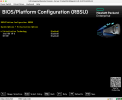HI, I am having trouble setting up IOMMU for pci passthrough on my system. The server is a HP ProLiant DL380 Gen9 running proxmox 6.0-4. I have enabled all the virtualization options within the bios including vt-d.
I followed the instructions on the wiki to set up iommu support, but proxmox still reports that it cannot detect IOMMU when I try to add a new pci device to a vm. In addition all the devices in the dropdown show up belonging to the same IOMMU group "-1".
The output from "dmesg | grep -e DMAR -e IOMMU" is:
I followed the instructions on the wiki to set up iommu support, but proxmox still reports that it cannot detect IOMMU when I try to add a new pci device to a vm. In addition all the devices in the dropdown show up belonging to the same IOMMU group "-1".
The output from "dmesg | grep -e DMAR -e IOMMU" is:
[ 0.027294] ACPI: DMAR 0x000000007B7E7000 00032A (v01 HP ProLiant 00000001 HP 00000001)
[ 3.746102] DMAR: Host address width 46
[ 3.746106] DMAR: DRHD base: 0x000000fbffc000 flags: 0x0
[ 3.746118] DMAR: dmar0: reg_base_addr fbffc000 ver 1:0 cap 8d2078c106f0466 ecap f020df
[ 3.746123] DMAR: DRHD base: 0x000000c7ffc000 flags: 0x1
[ 3.746132] DMAR: dmar1: reg_base_addr c7ffc000 ver 1:0 cap 8d2078c106f0466 ecap f020df
[ 3.746137] DMAR: RMRR base: 0x00000079174000 end: 0x00000079176fff
[ 3.746141] DMAR: RMRR base: 0x000000791f4000 end: 0x000000791f7fff
[ 3.746145] DMAR: RMRR base: 0x000000791de000 end: 0x000000791f3fff
[ 3.746149] DMAR: RMRR base: 0x000000634a1000 end: 0x000000674a0fff
[ 3.746153] DMAR: RMRR base: 0x000000674a1000 end: 0x0000006b4a0fff
[ 3.746156] DMAR: RMRR base: 0x000000791cb000 end: 0x000000791dbfff
[ 3.746160] DMAR: RMRR base: 0x000000791dc000 end: 0x000000791ddfff
[ 3.746166] DMAR-IR: IOAPIC id 10 under DRHD base 0xfbffc000 IOMMU 0
[ 3.746171] DMAR-IR: IOAPIC id 8 under DRHD base 0xc7ffc000 IOMMU 1
[ 3.746174] DMAR-IR: IOAPIC id 9 under DRHD base 0xc7ffc000 IOMMU 1
[ 3.746178] DMAR-IR: HPET id 0 under DRHD base 0xc7ffc000
[ 3.746182] DMAR-IR: Queued invalidation will be enabled to support x2apic and Intr-remapping.
[ 3.747344] DMAR-IR: Enabled IRQ remapping in x2apic mode

